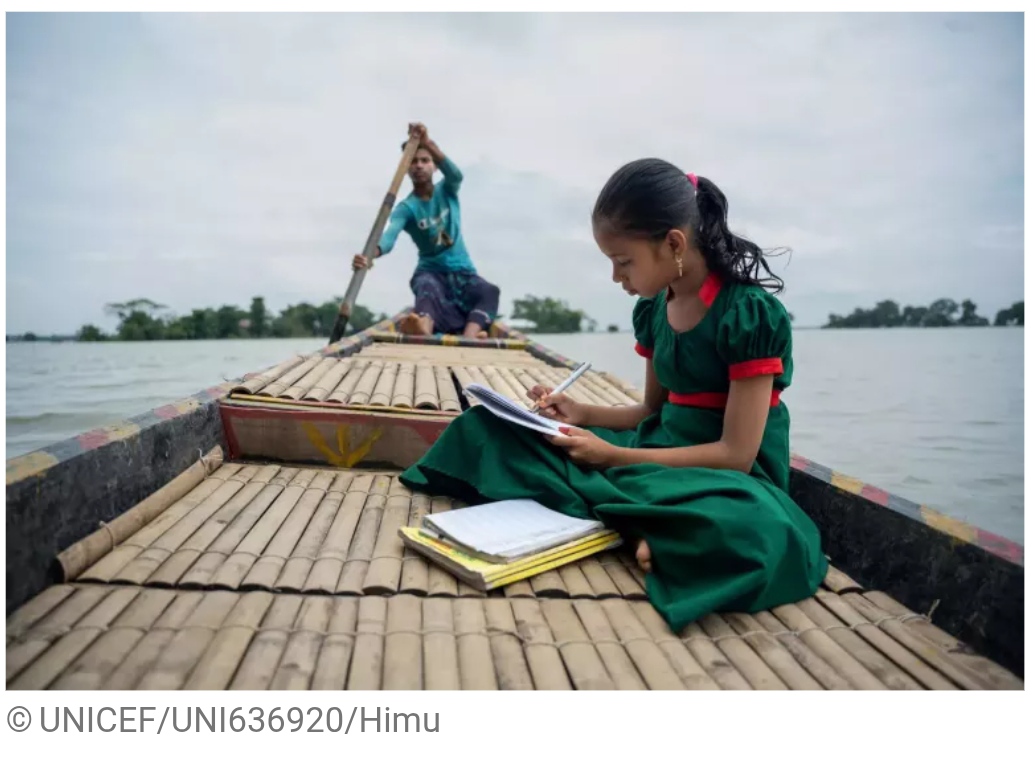Over 240 Million Students Affected by Climate-related School Disruptions in 2024, Warns UNICEF.
Education in Afghanistan, Bangladesh, Mozambique, Pakistan and the Philippines most severely affected by heatwaves, cyclones, floods and storms.
New York:
A startling new report by UNICEF reveals that in 2024, extreme climate events disrupted the education of at least 242 million students across 85 countries. The analysis, titled Learning Interrupted: Global Snapshot of Climate-Related School Disruptions in 2024, highlights how heatwaves, tropical cyclones, floods, storms, and droughts forced widespread school closures or significant changes to school timetables, further deepening the global learning crisis.
The report was released on the occasion of International Day of Education and paints a grim picture of the increasing frequency and intensity of climate hazards impacting the education sector. The analysis covers disruptions from pre-primary to upper secondary education, illustrating how extreme weather events have compounded existing challenges in global education systems.
Heatwaves Lead to Widespread Closures.
Heatwaves were identified as the most prevalent climate hazard, with over 118 million students affected in April 2024 alone. Countries like Bangladesh and the Philippines faced widespread school closures due to extreme heat, while Cambodia had to reduce school hours by two hours to mitigate the impact of soaring temperatures. In South Asia, temperatures reached a staggering 47 degrees Celsius (116 degrees Fahrenheit) in May, putting children at risk of heat-related illnesses.
“Children are particularly vulnerable to the effects of extreme weather, including heatwaves, floods, and storms,” said UNICEF Executive Director Catherine Russell. “Their bodies heat up more quickly, sweat less efficiently, and cool down more slowly than adults. When schools are closed or unsafe, it significantly disrupts their education and development.”
Multiple Climate Hazards in Some Regions.
In countries like Afghanistan, climate hazards occurred simultaneously. Besides intense heatwaves, severe flash floods damaged over 110 schools in May, halting education for thousands of students. Similarly, South Asia faced the highest levels of disruption, with 128 million students affected in 2024. East Asia and the Pacific followed closely with 50 million students impacted, and Africa was also severely affected by El Niño-related climate disasters.
In September 2024, a particularly challenging period for students, at least 16 countries suspended classes due to extreme weather events. Typhoon Yagi, which hit East Asia and the Pacific, alone impacted 16 million children, compounding the already precarious start of the school year for many.
Education Systems Ill-prepared for Climate Disasters.
The report also revealed that climate-related disruptions to education were most pronounced in low- and lower-middle-income countries, where nearly 74 percent of affected students live. In these regions, educational infrastructure is often poorly equipped to withstand the impacts of extreme weather events, and many children are unable to return to school after closures. In fragile contexts, extended school closures have been linked to an increase in child marriage and child labor, especially for girls.
In addition to immediate disruptions, climate hazards also undermine long-term education outcomes. Floods, storms, and other disasters can damage school infrastructure, impede access to safe learning environments, and negatively affect students’ concentration and mental health.
Urgent Calls for Climate-Resilient Education Systems.
UNICEF has called for immediate action from world leaders and the private sector to protect children from climate impacts by prioritizing education in climate adaptation efforts. This includes ensuring that national climate plans strengthen education systems’ resilience to disasters, investing in climate-smart and disaster-resistant schools, and accelerating funding for climate-resilient education solutions.
“Education is one of the most frequently disrupted services due to climate hazards, but it is often overlooked in policy discussions,” said Russell. “We must ensure that the futures of children are at the forefront of all climate-related plans and actions.”
The report also underlined the need for greater investment in climate-resilient school infrastructure. In Mozambique, for example, UNICEF has already supported the construction of over 1,150 climate-resilient classrooms in 230 schools, providing children with a safer learning environment amid recurrent cyclones.
Looking forward, UNICEF’s earlier State of the World’s Children report warned that climate crises will continue to worsen in the coming decades. By 2050-2059, the number of children exposed to extreme heatwaves is expected to be eight times higher than in the 2000s, while those at risk of extreme river floods could triple.
A Call to Action.
The analysis serves as a stark reminder of the urgent need to address climate change’s effects on education and ensure that children, especially those in vulnerable communities, are protected from its devastating impacts. Climate-resilient education systems, global investment, and integrated climate change education are crucial to safeguarding the future of the next generation.
As global temperatures continue to rise, it is clear that addressing the intersection of climate change and education must become a priority in global climate action plans.


